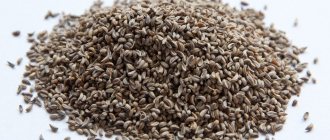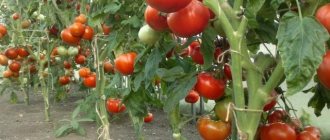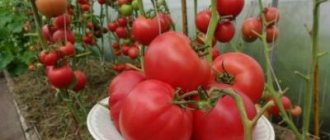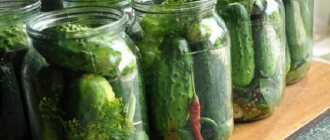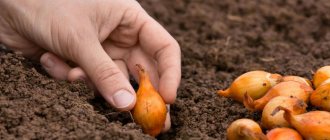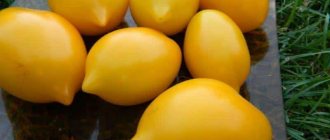How to speed up the ripening of tomatoes? What is needed to quickly ripen tomatoes? How to process tomatoes, what and how to feed them? What folk remedies are used for this? Does alcohol and vodka really help? Differences for greenhouse tomatoes and those growing in open ground. How to speed up the ripening of tomatoes picked green at home, basic rules. And finally, a useful video, expert opinion. Read, think, apply wisely. This way you will preserve your tomato harvest as much as possible, even if the weather conditions are no longer conducive to the ripening of tomatoes on the bush.
Why tomatoes don't ripen
Before we look at ways to speed up the ripening of tomatoes, let’s look at the reasons for their delayed redness.
Firstly, this is an incorrectly selected variety. Late-ripening tomato varieties have a longer growing season and take longer to ripen than early and mid-ripening varieties.
Therefore, it is very important to choose the right variety for your climate zone.
Secondly, the reason for the long ripening of fruits may be a cold and short summer.
Tomatoes are a heat-loving crop. For normal development and fruiting, the plant needs a warm summer with plenty of sun and pleasant temperatures.
If this is not the case, then the fruits will take a long time to fill. In addition, their taste will suffer.
Biotechnology - use of microbiological fertilizers to accelerate ripening
If you are a supporter of organic farming or simply do not want to use chemical synthesis products on your plot, you can treat the plants with biological preparations containing gibberellins. Moreover, any chemical, wittingly or unwittingly, can aggravate stress when processing plants.
Natural gibberellins are contained in liquid microbiological fertilizers, for example, “Rizoform”, “Biocomplex-BTU”. By using them in the appropriate stages of plant development (budding, flowering, fruit formation), through foliar feeding, you can accelerate the onset of phenological phases, while obtaining fully formed, high-quality and tasty products. However, you should not use microbiological fertilizers in the early stages of plant development, no doubt, this will increase biomass and yield, but will lengthen the growing season.
Also, various organo-mineral fertilizers work to increase the overall yield, but their active use can delay the ripening process, which is not very good in cold and damp summer conditions.
Growth regulators, including fruit formation regulators, open up enormous opportunities for plant control, and in the hands of an experienced person they can work wonders. But they are not a panacea that overcomes all problems at once, and, moreover, you should not overdo it with dosages according to the principle “the more, the better.” Determining the place of drugs in the overall system of plant care, a clearly defined goal, strict adherence to recommended concentrations and consumption rates - these are the foundations for the competent use of these drugs and the key to your success.
How to speed up the ripening of tomatoes in open ground
Next, let's look at some proven methods that will help tomatoes turn red faster.
Removing stepchildren
This procedure helps to thin out tomato plantings and provide the fruits with the necessary level of light for ripening.
Breakage of leaves on the lower tiers
Old leaves take up too much nutrition and energy. As a result, practically nothing reaches the fruits located on the upper tiers. Gradually pick off the leaves under the fruits, and they will begin to ripen faster.
Pinching the top of the head
In the last ten days of July and early August, you can pinch to stop the growth of the tomato.
As a result, nutrients will begin to spread throughout the plant, including the fruits.
Pick brown tomatoes
If the tomatoes begin to turn red, pick them every 3-4 days. If you wait until they are completely ripe on the branch, you will have to wait even longer for the next fruits.
Treatment with compounds that accelerate ripening
You can speed up the process of reddening of tomatoes by spraying with special compounds. Let's look at some of the most popular ones:
- Iodine water. You need 30 drops per bucket of water. Apply in the morning or evening after the heat of the day has subsided.
- Magnesium sulfate. You need 2 teaspoons of the drug per bucket of water.
- Superphosphate. Fertilizer is prepared in several stages. First, 2 tablespoons of the drug are dissolved in 2 liters of water and left to infuse for a day. Then the volume of working fluid is increased to 10 liters and the tomatoes are sprayed.
- Potassium humate. The working solution is prepared according to the instructions. Treatment can be carried out every ten days.
Watering with special compounds
In addition to spraying, tomatoes can be watered to speed up ripening. Let's look at some compositions.
- Pink solution of potassium permanganate. Used for irrigation when spraying is not possible.
- Ash infusion. Pour a glass of ash into a bucket and leave for 2 hours. Afterwards, water the tomatoes and feed them with ash infusion at the rate of 1 liter per 1 bush.
Covering tomatoes
Caring for tomato bushes for early ripening
Tomatoes must be pinched (except for those varieties that say they don’t need pinching). Because if the stepsons are not removed, the plant will form many shoots with flower clusters. All of them will not have time to ripen, but at the same time they greatly delay the ripening period of the first tomatoes. Plants from which excess shoots are not removed are very thick and poorly lit by the sun. As a result, without sufficient lighting, tomatoes do not ripen well.
Useful articles for gardeners and gardeners
Fried eggplant recipes: quick and tasty
Eggplant: quick and tasty stewed recipes
Eggplants like mushrooms recipes, quick and tasty
Eggplants for the winter are like mushrooms without sterilization
It is necessary to remove the lower leaves in a timely manner. This will help the plant direct all its forces to the growth and ripening of the crop. As a rule, inexperienced gardeners do not know at what point and how to prune leaves correctly. And this must be done carefully and according to certain rules. Otherwise, the plant can be damaged to the detriment of the future harvest. Pruning of tomato bushes begins with the lower aging leaves. Gradually you need to remove the leaves under each brush that begins to fill. How to trim tomato leaves correctly and in what time frame can be read here.
When tomatoes ripen, you need to reduce watering. This also affects the ripening process of tomatoes;
Proper feeding. When tomatoes begin to ripen, fertilizing with nitrogen fertilizers should be minimized. Otherwise, the plants will increase the volume of green mass, not fruits. In addition, excess nitrogen fertilizers worsens the taste of fruits;
At the end of July - beginning of August, you need to remove the growing point - top the bush. That is, cut off the top of each stem with a flower cluster so that the plant does not waste energy on forming new ovaries. As a result, all forces and nutrients will be directed towards ripening; It makes no sense to bring tomatoes in the garden to full ripeness, since this reduces their overall yield. To enable the remaining fruits to ripen as quickly as possible, you need to pick brown unripe tomatoes from the bushes 1-2 times a week.
How to speed up the ripening of tomatoes in a greenhouse
In principle, everything that has been said for tomatoes growing in a garden is also true for bushes growing in a greenhouse.
But still, we will describe in more detail everything you need to know about stimulating ripening in a greenhouse.
- Be sure to carry out pinching and pinching the top of the head. These procedures will help redistribute nutrients and direct their flow to the redness of the tomatoes.
- Maintain the temperature around 25 degrees. This is the optimal temperature for the tomatoes to plump and ripen. Temperatures below 20 and above 35 stop the life processes inside the tomato.
- Provide the required level of illumination for plantings. The fruits of this crop need sun to turn red. If there is not enough of it, the fruits will turn red for a very long time.
- Using a smoke bomb. During the combustion process, carbon dioxide will be released, which tomatoes need to accelerate ripening.
Features of the use of plant growth regulators
When calculating the concentration of the working solution and choosing the timing of treatments, you should strictly adhere to the manufacturer’s instructions. Spraying with Emistima solution (1 drop per 1 liter) with the appearance of the first leaves and then at intervals of 1 month will help increase the yield of apple trees, garden strawberries, and black currants. Working fluid consumption – 10 l/100 m2.
Let's look at the features of using drugs using the example of "Bud".
If we grow tomatoes, then we need to dilute 15 g of the drug per 10 liters of water, at the rate of 4 liters of the prepared solution per hundred square meters. Spraying is carried out in the early flowering phases of 1st, 2nd and 3rd clusters.
To spray cucumbers, 20 g of the drug is diluted in 10 liters of water; treatment is necessary in the phase of the appearance of the first true leaf, the beginning of flowering and mass flowering.
Eggplants are sprayed in the same concentration as tomatoes, but in the budding phase and the beginning of flowering.
When preparing a solution for treating other crops (peppers, peas, cherries, currants, apple trees, strawberries, cabbage, potato and onion seeds, flowers), it is also necessary to follow the consumption rates specified in the instructions (alternatively, the regulations can be found in the catalog of registered pesticides and agrochemicals).
Separate types of ripening accelerators are also produced with the addition of humates and microelements in a composition adapted for different groups of crops; in this case, it is better to treat the plants with the appropriate type of preparation.
Treat plants either early in the morning or in the evening; in hot weather, preferably in the evening, in calm weather.
Proper watering during tomato ripening
During the ripening period, watering tomato beds can be reduced. The specific moisture regime depends on the varietal characteristics.
So, low-growing specimens can be stopped watering altogether in 3-4 weeks. But for tall tomatoes, watering needs to be reduced. You need to carry out the procedure twice a week (or even less often), but pour a little more water than usual.
When to feed?
To fertilize tomatoes, you need to choose a certain time of day and weather conditions.
- For open ground tomatoes, all spraying can be carried out in the morning or evening, and in cloudy weather - at any time. The main thing is that the treated bushes should not be exposed to sunlight, otherwise burns cannot be avoided.
- Spraying carried out in the evening hours is considered more effective, since all components of the solution are better absorbed into the plant and do not evaporate during the day.
- Root feeding of greenhouse tomatoes is carried out in the morning, followed by ventilation.
What not to do when the tomatoes are ripe
Now let’s look at what not to do when tomato fruits turn red.
- Eliminate nitrogen from the plant diet. This microelement is needed for the growth of green mass, but not for the ripening of fruits. In addition, nitrogen worsens the taste of tomatoes.
- Reduce watering. Tomatoes now have absolutely no use for excess moisture. The procedure may cause the fruit to burst.
- Eliminate organic fertilizers.
Onions and garlic
The secret to quickly ripening onions is not to over-water. Experienced summer residents even take this step: they do not water the onions for two weeks. If it rains, the onions are covered with polyethylene film (transparent, so as not to deprive them of light). In this way, you kill several birds with one stone - you speed up the ripening of onions and reduce the risk of fruit rotting.
Also, in order for the onions to ripen faster, you need to remove excess soil from the bulbs. The onion is opened halfway or even more to allow air to enter. During the ripening period of onions, it is usually much warmer in the air. This will allow you to harvest a few weeks earlier.
You can also speed up the ripening process of garlic. Once you have removed the arrows, you can tie the garlic into a knot. Thus, the plant will direct more energy to ripening the fruits, rather than releasing new tops.
Traditional methods for accelerating the ripening of tomatoes
Summer residents have come up with quite a few unusual ways to speed up the ripening of tomatoes. Let's look at some of them.
Stimulation with ripe fruits
The essence of the method is that ripe fruits of other berries and fruits are hung on tomato beds. They release ethylene into the atmosphere, which accelerates the ripening of fruits.
Piercing
Disinfect a toothpick with alcohol and pierce the fruit in several places around the stem. The puncture does not need to be larger than 10 mm.
It has been noted that pierced tomatoes ripen faster.
ON A NOTE. Please note that such tomatoes will not have a marketable appearance. The method is applicable only to fruits that will be processed or eaten.
Through cut
At a level of 15-20 cm from the ground, a sharp knife is used to make a through puncture in the main shoot of the bush. Then a “spacer” (wooden stick) is inserted inside. This mobilizes all the forces of the plant to bear fruit.
REFERENCE. If you insert a piece of copper wire into such a puncture, this will protect the bush from late blight and other fungal diseases.
Vodka “vaccinations”
You can speed up fruit ripening with vodka injections. You only need 0.5 ml for each fruit. Alcohol stimulates ripening.
Damage to small roots
Quite an unusual way. You need to grab the stem and pull the plant out of the ground until it cracks. This means that small roots have been damaged. Now the energy will be redirected to the fruits.
IMPORTANT! This method is very controversial. We do not recommend using it unless you have sufficient experience growing tomatoes.
Turning towards the sun
Remove any leaves that protect the tomatoes from the sun. Rotate the brushes and fix them so that they are always illuminated.
Stimulating tomato growth with alcohol
As mentioned above, ethyl alcohol can accelerate the ripening of tomatoes. Interestingly, recent experiments conducted by scientists have proven this theory in practice. Therefore, now there is no reason not to take and try this maneuver yourself on the tomato harvest. In order for the experiment to end with complete success, we must take only 0.5 ml of our Russian vodka and use a syringe to give it a drink through the nest of a green tomato. The ripening of fruits will be significantly accelerated - in two weeks they will be completely ripe and ready for consumption. It is also important that the quality of the fruit will not be affected at all - the taste will remain the same.
How to ripen green tomatoes
You can also pick green tomatoes and then ripen them at home.
Milky-wax specimens are suitable. Elastic and dry. That is, the fruits should already be almost ripe, just not reddened.
You need a box or wooden box where unripe fruits are placed in one layer. Then the box is placed in a dark place with high humidity.
The advantage of this method is that you can control the speed at which the tomatoes turn red. In warm conditions (25-30 degrees), the fruits will ripen quickly, in 3 days. In cool weather (+10) for a week and a half.
ON A NOTE. There is another way. Bushes are pulled out of the ground and hung upside down indoors.
How to ripen green tomatoes at home
The process of ripening tomato fruits at home is called ripening. Not all tomatoes are suitable for ripening. They should be harvested at the stage of milky-waxy ripeness, and not earlier. Otherwise, instead of ripe tomatoes, you will have wrinkled, wilted fruits. Of course, for ripening you need to take only strong and elastic tomatoes. When collecting, they must be dry.
Tomatoes that have become shiny and grown to a certain size must be removed from the bush. They ripen well in a room with a stable temperature. In addition, such fruits are better stored, as they are denser and not overripe. And they taste better than overexposed ones, and more nutrients will be available for those remaining on the bush.
The collected tomatoes are laid out in small layers in boxes or on the floor - on newspapers or old waste cloth. If there was a risk of tomatoes being infected with late blight, these tomatoes should be placed separately. Because they need to be watched. Due to the spread of the disease, they can turn black at once. It may be better not to risk it and remove them right away.
The ripening time of unripe tomatoes depends not only on the degree of ripeness of the fruit, but also on the conditions of their storage, especially temperature.
- If you need slow ripening of picked tomatoes, then select tomatoes that are approximately equal in size, lay them in two or three layers, sprinkle them with sawdust. The room temperature should not be higher than 10°C, humidity 80-85%. If the air is dry, the fruits will quickly become flabby and wrinkled. Sunlight accelerates ripening, so a darkened room is preferable for long-term storage.
- For rapid ripening of tomatoes (7-10 days), a temperature of 20-24°C (warm room) is required.
- For very quick ripening (just a few days), the tomatoes are kept in the sun at an air temperature of 28-30°C.
Common mistakes
In an effort to speed up the ripening of tomatoes, gardeners often make mistakes. Let's sort them out.
- Excessive watering. This is the most common and most serious mistake. When a summer resident sees that the fruits do not want to turn red, he thinks that they do not have enough water. But excessive watering only leads to cracking of the fruit.
- No procedures are carried out at all. Left to their own devices, tomatoes will take a very long time to ripen.
- Growing unsuitable varieties. Not everywhere in Russia you can grow late-ripening varieties of tomatoes. In many regions, tomatoes simply do not have time to ripen.
- Organic feeding. Tomatoes do not need excess nutrients at the fruit ripening stage.
Why tomatoes do not turn red for a long time on the bush and why early ripening of tomatoes is needed
The country of evergreen tomatoes is not for nothing that people have such a name for. As a rule, in the middle zone the summer is short and tomatoes do not have time to ripen and ripen on the root. The further the harvest date is delayed, the more dangerous it becomes to contract the dangerous disease late blight. In the second half of summer, late blight can destroy all the bushes and the entire tomato crop in a couple of days.
Of course, the ripening time of a tomato depends on the variety (early, late, mid-ripening). But it is possible to artificially create conditions for earlier ripening of fruits.
Answers to frequently asked questions
Tomatoes don't turn red, what should I do?
Stimulate their maturation using any method available to you. You can pick green fruits and ripen them at home.
Is it possible to pick green fruits?
Yes. If they have acquired a milky-waxy tint. You can put them in a box and they will ripen there.
Do I need to pick off the leaves?
It is advisable, but there is no need to cut everything off. Just tear off everything below the first bunch of tomatoes.
Why tomatoes don't ripen well
Tomatoes not ripening have many reasons. Plants require good and proper care; if these rules are not followed, there is a chance you will be left without a harvest. Negative factors affecting the ripening of tomatoes:
- improper watering and pruning of the bush;
- lack or absence of microelements;
- too dense planting;
- lack of sun and heat;
- incorrect or untimely feeding.
The timely ripening of a vegetable such as a tomato is influenced by the location of the bushes in the garden. To speed up the ripening process, you need to understand how the fruit yield on one bush depends on the number of daughter shoots.
The presence of many daughter shoots on a tomato bush significantly reduces the ripening of the vegetable. Since the formed ovary requires nutrition and sunlight for its growth. Accordingly, if such shoots are not closely monitored, the harvest will be reduced significantly, and the fruits themselves will significantly lose in size and taste.
What you can and cannot do during the ripening period of tomatoes
All feeding of tomatoes is done before the fruits begin to ripen.
At the moment of ripening of the future tomato crop, it is strictly forbidden to:
- water the crop generously;
- carry out nitrogen fertilization.
In the first case, the tomatoes will crack. If the tomatoes absolutely do not have enough moisture, then it is better to mulch the soil with wet hay or sawdust.
In the second, all fertilizing with mullein, green fertilizers or chicken droppings should be stopped after mid-summer. Fertilizers of this type cause a sharp increase in the green mass of the plant, but not the fruit. Moreover, the taste of tomatoes may deteriorate.
But it is quite possible to prevent late blight during the fruiting period. To do this, you can use an infusion of garlic or organize shelter for the bushes at night.
Methods affecting the development of tomato fruits
It is necessary to influence this parameter starting from the stage of preparing seeds for sowing. In most temperate regions, seeds are placed in the soil to produce seedlings in March. There are a number of varieties with remarkable characteristics, with the exception of one - they do not have time to ripen during the summer months. This state of affairs is not a reason to refuse to grow the variety you like.
One way to influence the process is to remove the stepsons growing from the buds of the main stem. If this is not done, then a large number of flowers will form first, and then ovaries, which ultimately prevent each other from ripening quickly. Rapid ripening of tomatoes will occur provided that the bush forms one main stem or an additional small number of side shoots.
Several schemes for forming a tomato bush have been developed:
- in 1 stem;
- in 2 stems;
- in 3 stems.
In the first case, the side shoots are completely removed. In the second, all stepchildren are also removed, except for those located under the first inflorescence. In the variant with three stems, in addition to the above parts, the lowest strong shoot is left. Removal of excess shoots begins when they reach a length of 5 cm. After removal, stumps are left, the size of which should not exceed 1 cm.
Tomatoes. The illustration for the article is used under the standard license ©v-ogorode.ru
At the end of the last month of summer, already fruiting shoots are pinched. In this case, flowers that do not have time to ripen in time and the tops of the branches are cut off. If this procedure is not so important for low-growing varieties, then for tomatoes with a tall stem the procedure is mandatory. When growing low-growing varieties, experienced gardeners suggest installing small spacers, the main task of which is to help turn the fruits towards the sun. In this case, the tomatoes should not touch the ground.
Fertilization can speed up ripening. Additives in the form of compost, rotted manure, and wood ash can affect the speed of ripening.
Valery's recommendations for accelerated ripening of tomatoes
Valery, the host of the blog “Garden with your own hands,” also gives vegetable growers valuable advice. He also advises making tomatoes turn red by stressing them. To do this, you need to force them to produce the stress hormone - ethylene. What kind of hormone is this?
Many gardeners have wondered about the fact: why do wormy apples ripen faster? This is because damage leads to the production of ethylene, a stress hormone.
This means that tomatoes must be forced to produce this hormone. How:
- On bushes with green fruits, you must leave one ripe fruit. Ethylene is a volatile substance that spreads quickly in space. Touching other fruits, it makes them fill with ripeness.
- You also need to lightly tug the roots so that the bushes get stress. The supply of moisture and nutrients will decrease, the fruits will begin to take them from the bush and ripen faster. Even small tomatoes will turn red.
- A month before ripening, it is necessary to remove the top of the bushes to speed up the filling speed.
- The brush on which unripe fruits remain must simply be pinched in the place where it grows to the bush.
- Reduce watering and fertilizing to speed up the ripening of the crop.

